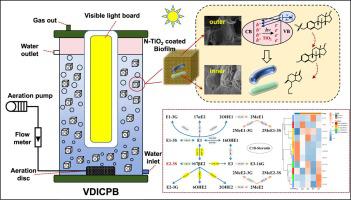当前位置:
X-MOL 学术
›
Bioresource Technol.
›
论文详情
Our official English website, www.x-mol.net, welcomes your feedback! (Note: you will need to create a separate account there.)
Degradation of conjugated estrogen in visible light-driven intimately coupled photocatalysis and biodegradation system
Bioresource Technology ( IF 9.7 ) Pub Date : 2024-06-26 , DOI: 10.1016/j.biortech.2024.131045 Xiangwei Ding , Qingmiao Yu , Hongqiang Ren , Jinju Geng
Bioresource Technology ( IF 9.7 ) Pub Date : 2024-06-26 , DOI: 10.1016/j.biortech.2024.131045 Xiangwei Ding , Qingmiao Yu , Hongqiang Ren , Jinju Geng

|
Visible light-driven intimately coupled photocatalysis and biodegradation (VDICPB) is an efficient technology for removing recalcitrant contaminants, but the degradation pathway on 17β-estradiol 3-Sulfate (E2-3S) is still not clear. In this study, VDICPB based on N-doped TiO as a photocatalyst was established to investigate the removal and transformation of E2-3S in synthetic wastewater. VDICPB showed a satisfactory removal efficiency of 97.8 ± 0.4 %, which was much higher than that of independent photocatalysis (84.0 ± 2.2 %) or biodegradation system (71.4 ± 1.8 %). Steroid C/D-rings of E2-3S was broken in VDICPB since the transformation process reached terminal central pathway. Primary metabolites did not accumulate in VDICPB, resulting in a low expression of functional genes. E2-3S was mainly removed by cooperative interaction of photocatalysis and co-metabolism of biofilm. Photocatalysis led to deconjugation and microbes acted to mineralization. This study provides technical reference and theoretical support for the removal of new pollutants.
中文翻译:

可见光驱动的紧密耦合光催化和生物降解系统中结合雌激素的降解
可见光驱动的紧密耦合光催化和生物降解(VDICPB)是一种去除顽固污染物的有效技术,但 17β-雌二醇 3-硫酸酯(E2-3S)的降解途径仍不清楚。本研究建立了基于N掺杂TiO作为光催化剂的VDICPB来研究合成废水中E2-3S的去除和转化。 VDICPB表现出令人满意的去除效率,为97.8±0.4%,远高于独立光催化(84.0±2.2%)或生物降解系统(71.4±1.8%)。由于转化过程到达末端中央通路,E2-3S 的类固醇 C/D 环在 VDICPB 中断裂。初级代谢物在VDICPB中不积累,导致功能基因低表达。 E2-3S主要通过光催化和生物膜共代谢的协同作用被去除。光催化导致解离,微生物作用于矿化。本研究为新型污染物的去除提供技术参考和理论支持。
更新日期:2024-06-26
中文翻译:

可见光驱动的紧密耦合光催化和生物降解系统中结合雌激素的降解
可见光驱动的紧密耦合光催化和生物降解(VDICPB)是一种去除顽固污染物的有效技术,但 17β-雌二醇 3-硫酸酯(E2-3S)的降解途径仍不清楚。本研究建立了基于N掺杂TiO作为光催化剂的VDICPB来研究合成废水中E2-3S的去除和转化。 VDICPB表现出令人满意的去除效率,为97.8±0.4%,远高于独立光催化(84.0±2.2%)或生物降解系统(71.4±1.8%)。由于转化过程到达末端中央通路,E2-3S 的类固醇 C/D 环在 VDICPB 中断裂。初级代谢物在VDICPB中不积累,导致功能基因低表达。 E2-3S主要通过光催化和生物膜共代谢的协同作用被去除。光催化导致解离,微生物作用于矿化。本研究为新型污染物的去除提供技术参考和理论支持。






































 京公网安备 11010802027423号
京公网安备 11010802027423号